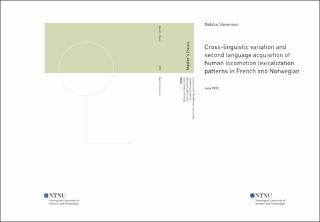| dc.description.abstract | Cross-linguistic variation is incredibly prevalent and has led to various questions regarding human language and cognition. Such variation predominantly reflects differences in lexicalization strategies across languages, and investigating these patterns is a useful tool for researchers to examine what is possible in the languages of the world, i.e., ‘thinking for speaking’ patterns. An interesting avenue to explore these topics is through the study of human locomotion. Talmy proposed a typological classification of motion events, separating languages in terms of where the element of Path is encoded in a language’s structure. However, many authors criticized this typology, including Vulchanova and colleagues who suggested that languages should instead be addressed through a set of parameters and conceptual features. Further, cross-linguistic variation begs the question of how the acquisition of second languages may be impacted, for which there is no current consensus. The present thesis reviews some of the most prevailing research surrounding these issues and assesses their validity with a behavioural free naming task. The aim of the present study is to determine (i) whether speakers employ the naming patterns predicted in previous research, and (ii) to what extent different encoding strategies between the L1 and L2 impact second language acquisition. Six L1 Norwegian speakers of beginner-intermediate L2 French were recruited and asked to describe 20 videos of human locomotion in both languages. L2 descriptions were compared to labels provided by six native French speakers. L1 Norwegian descriptions were compared to those provided by two native Norwegian pilot participants. Results from both native speaking control groups indicated that speakers primarily employed patterns predicted by previous research. No evidence of transfer was confirmed amongst L2 speakers, perhaps attributed to the L1’s more complex lexical inventory relevant to the patterns of motion in this study. L2 speakers tended to behave similar to native speakers in basic patterns of human locomotion; however, when presented with more complex patterns, L2 labels displayed more errors, and significantly more variation in general. Those with higher L2 proficiency levels performed closer to L1 speakers overall, indicating that some lexicalization patterns in this domain may be acquired in later stages of second language acquisition. | |
